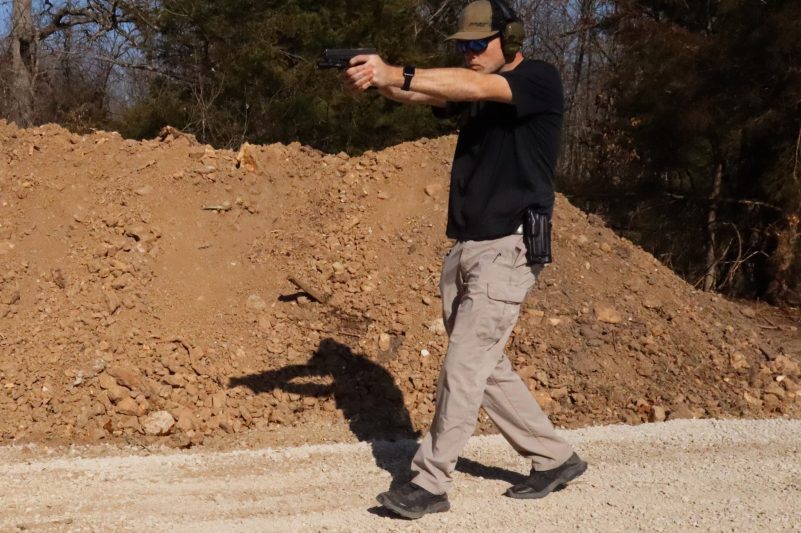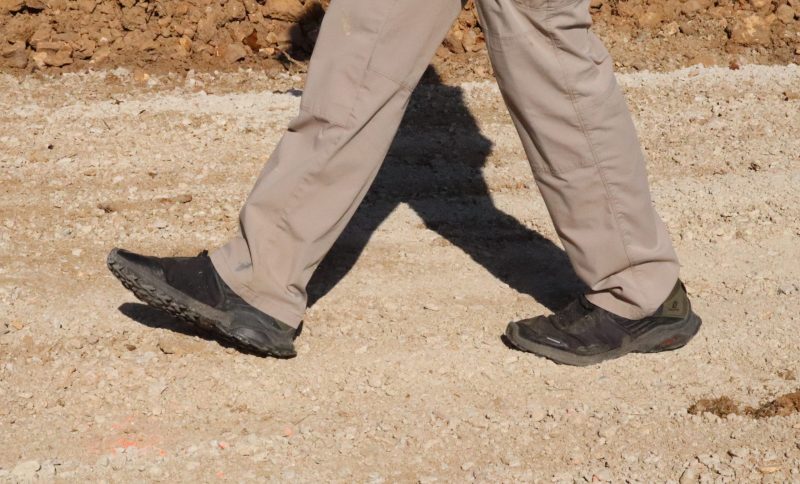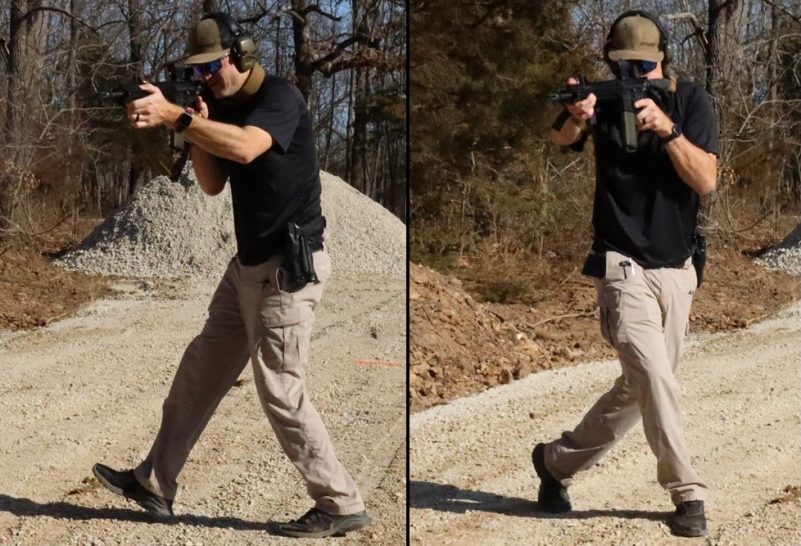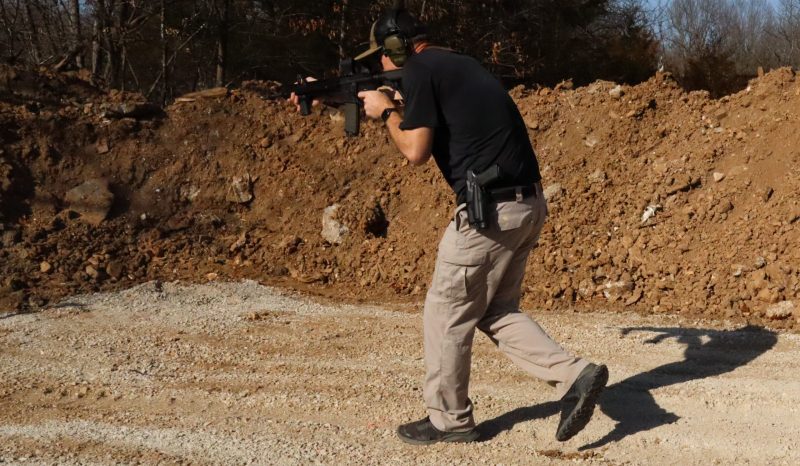Shooting is hard. There are few things easy about it. Shooting a firearm accurately is a divided-attention task. The shooter must maintain a consistent sight picture and alignment on the target. Meanwhile, their grip and stance must remain steady while their trigger finger manipulates the trigger without affecting sight alignment. Your brain’s attention is divided across multiple tasks when shooting. Again, shooting is hard.
Over the years, I’ve seen a lot of outstanding shooting while stationary. There was a time when I was “that guy.” Stationary shooting is relatively easy compared to shooting while moving. While this is perfectly acceptable and expected at most public and private ranges, it’s impractical and unrealistic for the real world. In a gunfight, planting your feet as you would on a flat range isn’t just absurd; it has life-altering (or ending) consequences.
Shooting on the Range vs the Real World
Examples of the importance of shooting while moving are prolific and easily accessible. In recent years, surveillance cameras, smartphones, law enforcement and personal dash cameras, and law enforcement body cameras have become prolific. The preponderance of videos capturing critical lethal force engagements provides a robust visual dataset.
In almost every video, those engaged in the gunfight or facing a lethal threat do one thing: they move. Unless something has short-circuited in the hard drive between the ears, our species inherently seeks out self-preservation when faced with potential harm. If shot at or charged by an upraised knife, we’d prefer to avoid their path. As such, we tend to move, whether it be to cover or out of an attacker’s trajectory.
Furthermore, the armed citizen is faced with an additional complexity to their dangerous conundrum. In these encounters, the armed citizen or law enforcement may have to act to neutralize the threat. Accordingly, these scenarios showcase an important part of defensive shooting—shooting while moving is critical to survival and threat neutralization during a violent encounter.
Shooting While Moving
So, you’ve recognized the importance of integrating movement into your defensive response. Now what? While it’s good to recognize a deficiency in your skillset, the next step should be resolving that shortcoming and making it a strength. Therefore, here are a few tips, tricks, and considerations for integrating movement into your shooting. The goal is to ensure that the good guys and girls win the fight. As the legendary shooter and law enforcement officer Bill Jordan coined, there’s no second-place winner in a gunfight.
Technique
The key to proficiently shooting on the move starts with timing and technique. These two factors are exceptionally important to building competent habits that the monkey brain will default to under stress. We don’t “rise to the occasion”. We default to the trained habits written on our mental hard drive.

Walking while shooting isn’t how we normally walk. The body assumes an athletic stance with the legs slightly bent. Take steps with the foot’s outside edge from heel to toe. This technique of stepping creates a rolling motion, much like a ball across the ground. Stepping on the outside of the edge of the heel and rolling it across the ground to the toe reduces the bounce many of us experience if we’ve ever tried to walk normally while looking through our sights. Our bent knees cushion this further. The stance isn’t vertical nor in a turtle-like crunch. This technique doesn’t require athleticism as much as it requires an athletic technique with the head over the toes.

You can practice this movement at home without a firearm. Place your arms in front of you and use a straightened index finger as your sights. While practicing, start finding the point where your “sights” are at their steadiest and most stable. What you may discover brings us to the next part of the movement while shooting.
Timing
While there are some who can mag dump while moving around the range like a Roomba vacuum, this skill starts with understanding when your shooting platform (e.g. your body holding the firearm) is most stable. If you’ve practiced some, you’ve probably noticed the firearm’s sights and your sight picture are most stable while both feet are on the ground. Of course, this makes sense. More points of contact to stabilize the firearm and ourselves translates to more points of contact between us and the ground.

One of the more common issues I see with introducing new shooters to shooting while moving starts with their timing. Ideally, fire each shot as both feet are on the ground. Simply start your trigger press as your foot begins to roll onto the ground. This timing produces a shot break at the moment your body is most stable. Fire one shot per step. With mastery of this timing, engagement while moving turns into a steady stream of rounds on the desired target.
One Step at a Time
Long before we learned to walk, we learned to crawl. With shooting while moving, you’re effectively learning to walk again. For new students, I start them with the firearm at low ready, then raise it to the target and take a step forward. As they step forward, they fire on the target. Repeat until they’re comfortable with the timing. This drill is suitable for lateral, forward, and reverse shooting movements.
As you master one step, begin integrating additional steps into this to develop a cadence for each shot. With practice, the timing becomes second nature and smoother. Start small and build with practice.
Shooting and Lateral Movement
Once the fight starts, the goal is to end it quickly and decisively. This is a lethal force confrontation and you’re in the fight for the good folks to not end up on the losing end. While the belief may be to advance upon the target aggressively, this isn’t always the most intelligent or best course of action. The target’s background may have innocent life behind it and require you to move laterally for a clean backdrop. In the worst-case scenario, your movement may be retreating backward to cover. While not ideal, practice mitigates the hazards.

For lateral movement, avoid crossing your feet over each other. This is a tripping hazard, unstable, and inefficient. Rather, rotate your hips in the direction of movement while maintaining your body at the target. I compare this action to a tank turret. While not all of us are the most limber, we have some rotation in our hips and should be able to turn and walk in a direction while remaining engaged with our upper body and firearm on the threat. The footwork is the same. Your upper body’s orientation to your lower half is the only difference.
Do I ever back up?
Retreating backward during a gunfight sucks. What is even worse? Turning your back to the threat, losing visual, and running to cover. While a scenario may require this, I strongly recommend avoiding it. Movement backward is a tripping hazard.

To mitigate the risk of tripping backward, reach the foot behind the body and place the head slightly further beyond the toes. This offsets your balance forward but doesn’t impede rearward progress. If the body is straight and upright, the shooter can easily trip backward and lose their balance. While dangerous on the range, it’s tragic in the real world.
Movement is life
A coworker and friend once gave me some advice from his time in the Army. The words of wisdom were simple and poignant, “Movement is life.” That advice has stuck with me since. Stationary targets are easier to hit than moving ones. Anyone who has hunted knows the truth behind that statement. Ideally, our game should be stationary when we take the shot. Moving game, even at a walking pace, is more difficult to hit. This observation carries over to gunfights.
You don’t master shooting while moving overnight, and it is not a novice skill. While I try to avoid sounding like a broken record, I stress this topic more than anything else. Practice and master the fundamentals. From there, advance to more complex skills like movement. As such, seek out quality training that challenges you to build or improve these skills. It may just be the difference in who gets to go home.


